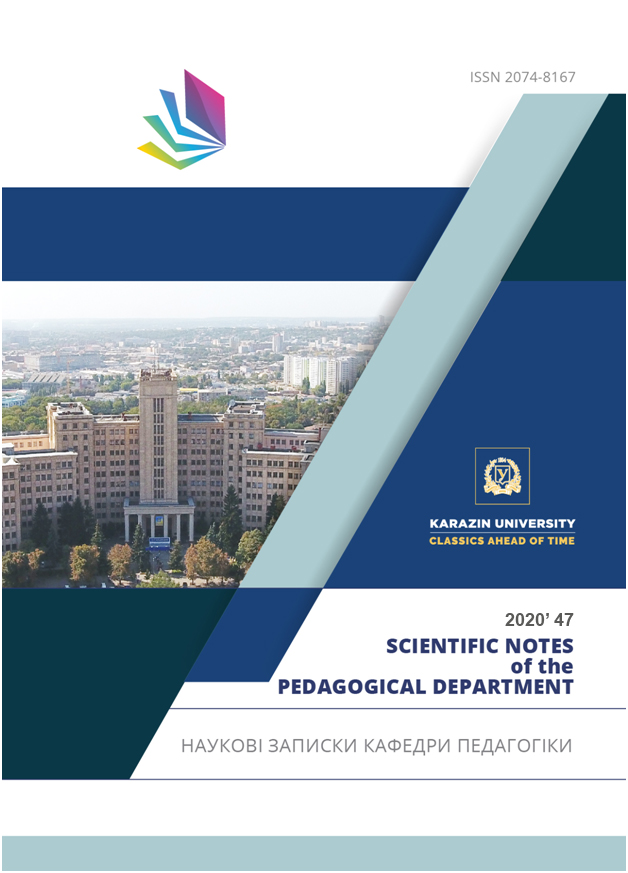Особливості вимушеного карантинного дистанційного навчання
Анотація
Стаття присвячена дослідженню поняття “дистанційна освіта” та його облив остей. В ній продемонстровано вивчення та аналіз різниці між різними формами дистанційного навчання, їхні позитивні та негативні риси. Останнім часом стрімкі зміни, зумовлені процесом модернізації, впливають майже на всі сфери людського життя, включаючи й освітню. У свою чергу, формат дистанційного навчання набув і продовжує набувати більшої популярності завдяки тому, що є більш зручним і, отже, ефективним. Однак в Україні все ще існує певне упередження щодо нестандартних форм навчання; більшість учнів шкіл не знаю про можливість отримати освіту по-іншому, хоча існуючі школи, що спеціалізуються на дистанційному навчанні, пропонують різні варіанти. На жаль, на зміни в освіті також уплинув спадах епідемії через COVID-19, який змусив країни у всьому світі, включаючи Україну, переглянути освітню систему та запропонувати її нові формати. Наша робота спрямована на розрізнення стандартного дистанційного навчання, яке також можна назвати “навчанням за індивідуальним планом”, від “вимушеного карантинного дистанційного навчання”, виокремлення їхніх позитивних та негативних рис і формування висновку про те, яка форма навчання є більше ефективною. Стаття також включає опитування, результати якого подані зі схемами, що ілюструють думки українських школярів та батьків стосовно впровадження вимушеного дистанційного навчання.
Завантаження
Посилання
/Посилання
Дистанційна школа «Джерело» запрошує до 1-11 класів. URL: https://www.youtube.com/watch?v=ysUUNxAdMkU (Дата звернення: 26.10.2020).
Карпенко М. Розвиток дистанційного навчання як відповідь на сучасні виклики для України. Стратегічні пріоритети. Нац. ін-т стратегічних досліджень. 2014. № 4 (33). С. 102–108.
Марусей Т., Білик, Т. Cучасні тенденції розвитку дистанційної освіти в Україні. Science, Research, Development. Pedagog. 2018. (8). 14-17.
Наливаи̮ко О. Дистанціи̮не навчання: сутність та особливості. Педагогічний альманах. 2017. 36. C. 75-81.
Наливайко О., Вакуленко А., Землин Ю. Порівняльна характеристика класичного дистанційного навчання та його підвидів на прикладі викладання у закладах загальної середньої освіти. Всеукраїнська науково-методична конференція «Теорія і практика реалізації сучасних педагогічних методик та технологій в освіті» 19-20 листопада 2020 року Присвячена 170-річчю заснування кафедри педагогіки». Харків.
Офійний Ютуб канал. Дистанційна школа Джерело. Директор дистанційної школи “Джерело” про дистанційну освіту. URL: https://www.youtube.com/watch?v=AWGQYf9so5U (Дата звернення: 26.10.2020)
Офіційний сайт Джерело центр дистанційної освіти. Дистанційна школа №1 в Україні. URL: https://cdo.org.ua/ (Дата звернення: 15.11.2020)
Офіційний сайт МОН України. Відповіді на Топ-15 найпоширеніших запитань батьків про індивідуальну форму навчання в школі – роз’яснення МОН. URL: https://mon.gov.ua/ua/news/vidpovidi-na-top-15-najposhirenishih-pitan-batkiv-pro-individualnu-formu-navchannya-v-shkoli-rozyasnennya-mon (Дата звернення: 08.10.2020)
Офіційний сайт. Центр освіти «ОПТІМА». Дистанційна загальноосвітня школа (1-11 класи) URL: https://optima.school/ (Дата звернення: 26.10.2020)
Петькова Ю. История развития дистанционного образования. положительные и отрицательные стороны МООС. Успехи современного естествознания. 2015. № 3. 199-204.
Galusha, J. M. (1997). Barriers to learning in distance education. Interpersonal Computing and Technology: An Electronic Journal for the 21st Century, 5(3/4), 6–14.
Harting, K., & Erthal, M. J. (2005). History of distance learning. Information technology, learning, and performance journal, 23(1), 35-44.
Valentine, D. (2002). Distance learning: Promises, problems, and possibilities. Online journal of distance learning administration, 5(3). URL: https://www.westga.edu/~distance/ojdla/fall53/valentine53.html (Дата звернення: 26.10.2020).
Dy`stancijna shkola “Dzherelo” zaproshuye do 1-11 klasiv (2020) [Distance school “Dzherelo”invites to grades 1-11]. Retrieved from: https://cdo.org.ua/ (in Ukrainian).
Karpenko, M. (2014). Rozvy`tok dy`stancijnogo navchannya yak vidpovid` na suchasni vy`kly`ky` dlya Ukrayiny` [Development of distance learning as a response to modern challenges for Ukraine]. Strategichni priory`tety`. Nacionl`ny`j insy`tut strategichny`x doslidzhen – Strategic priorities. National Institute for Strategic Studies. № 4 (33). pp. 102–108 (in Ukrainian).
Marusei, T., & Bilyk, T. (2018). Cuchasni tendenciyi rozvy`tku dy`stancijnoyi osvity` v Ukrayini [Current trends in the development of distance education in Ukraine]. Science, Research, Development. Educator. 8. 14-17 (in Ukrainian).
Nalyvaiko, O. (2017). Dystantsiine navchannia: sutnist ta osoblyvosti [Distance Learning: Essence and Features]. Pedahohichnyi almanakh – Pedagogical almanac, 36, 75-81 (in Ukrainian).
Nalyvayko O., Vakulenko A., Zemlin U. (2020, November 19-20). Porivnyalʹna kharakterystyka klasychnoho dystantsiynoho navchannya ta yoho pidvydiv na prykladi vykladannya u zakladakh zahalʹnoyi serednʹoyi osvity [Comparative characteristics of classical distance learning and its subspecies on the example of teaching in general secondary education]. Paper presented at All-Ukrainian scientific-methodical conference “Theory and practice of implementation of modern pedagogical methods and technologies in education” Dedicated to the 170th anniversary of the Department of Pedagogy. Kharkiv. (in Ukrainian).
Official YouTube channel of Distance School “Dzherelo” (2020). dystantsiynoyi shkoly “Dzherelo” pro dystantsiynu osvitu [Director of the distance school “Dzherelo” on distance education]. Retrieved from:
https://www.youtube.com/watch?v=AWGQYf9so5U (Access date: 26.10.2020) (in Ukrainian).
Official site Distance School “Dzherelo”(2020). Dystantsiyna shkola №1 v Ukrayini [Distance school №1 in Ukraine]. Retrieved from:
https://cdo.org.ua/ (Access date: 15.11.2020) (in Ukrainian).
Official site of the Ministry of Education and Science of Ukraine (2020). Vidpovidi na Top-15 nayposhyrenishykh zapytanʹ batʹkiv pro indyvidualʹnu formu navchannya v shkoli – rozʺyasnennya MON. [The answers to the Top 15 most common questions of parents about the individual form of education at school – an explanation from the Ministry of Education and Science]. Retrieved from: https://mon.gov.ua/en/news/vidpovidi-na-top-15-najposhirenishih-pitan-batkiv-pro-individualnu-formu-navchannya-v-shkoli-rozyasnennya-mon (Access date: 08.10 .2020) (in Ukrainian).
Official site of the Education Center “OPTIMA”(2020). Dystantsiyna zahalʹnoosvitnya shkola (1-11 klasy) [Distance secondary school (K 1-11)]. Retrieved from: https://optima.school/ (Access date: 26.10.2020) (in Ukrainian).
Petkova Yu (2015). Istoriya razvitiya distantsionnogo obrazovaniya. polozhitel'nyye i otritsatel'nyye storony MOOC [History of the development of distance education. positive and negative aspects of MOOC]. Successes of modern natural science. No. 3. 199-204 (in Russian).
Galusha, J. M. (1997). Barriers to learning in distance education. Interpersonal Computing and Technology: An Electronic Journal for the 21st Century, 5(3/4), 6–14 (in English)
Harting, K., & Erthal, M. J. (2005). History of distance learning. Information technology, learning, and performance journal, 23(1), 35-44 (in English).
Valentine, D. (2002). Distance learning: Promises, problems, and possibilities. Online journal of distance learning administration, 5(3). Retrieved from: https://www.westga.edu/~distance/ojdla/fall53/valentine53.html (Access date: 26.10.2020) (in English).
Цитування
BLENDED LEARNING IN MEDICAL INSTITUTIONS OF HIGHER EDUCATION
Nalyvaiko Natalya & Nalyvaiko Oleksii (2021) Educological discourse
Crossref

